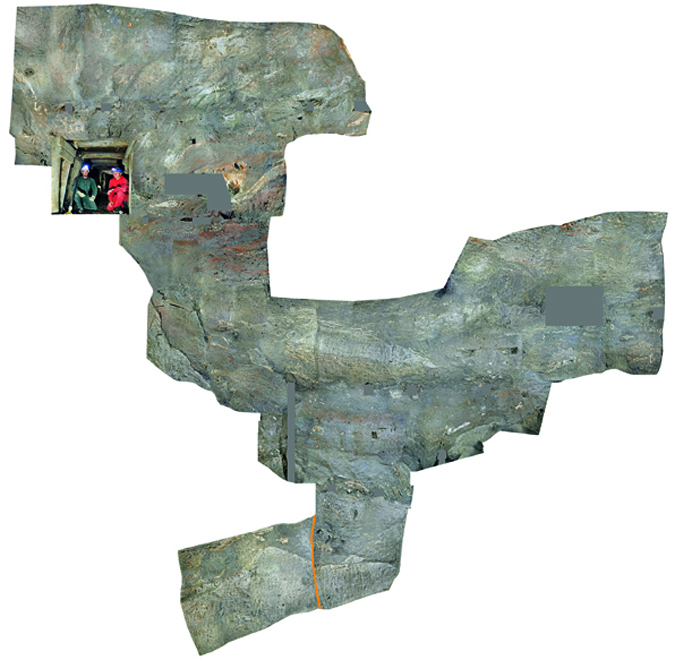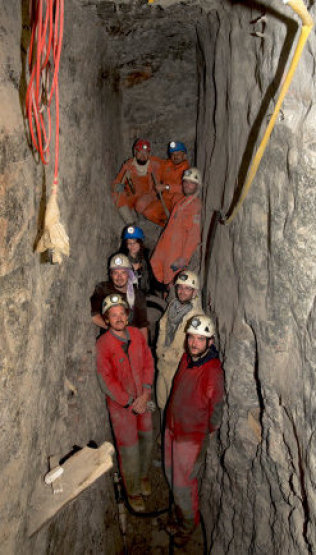Prehistoric salt mining on the Dürrnberg/Hallein, Austria
Contacts: Prof. Dr. Thomas Stöllner
thomas.stoellner@rub.de
The Dürrnberg – situated around 20 km south of Salzburg – is one of the most important Iron Age find sites in Central Europe: evidence of Late Iron Age (Latène period) salt mining and richly endowed graves give an idea of the social conditions and the intellectual culture of the salt mining metropolis. Contemporaneous settlement sites, some of them very well preserved, give information about the nature and extent of the crafts and trades connected with the salt. This unique linking of different archaeological sources makes the mining complex of Dürrnberg perfect for studies of economic archaeology, which can serve as models for other projects.

Fig. 01: Sleeve fragment from the mine (Georgenberg).
Excavations of an Underground Salt Mine
According to our present state of knowledge, the prehistoric salt industry was integrated into the surrounding countryside – both the foothills and the Alps themselves¬ – in various ways, and seems to have depended on long-distance trade for much of its income. Since 1990 studies have been carried out on the logistics of this large-scale Iron Age operation in the Alps. The extent of the find site and the outskirts of the settlements have been charted with modern prospection methods, and the number of find spots has increased substantially in recent years. The archaeological excavations are mainly focused on the underground salt mine. Thanks to the ongoing salt mining activities, prehistoric mining areas are accessible. However, the galleries are steadily falling into disrepair: of the 74 archaeological find sites which have been reported historically, only six can still be reached. Here, with the support of Salinen Austria, we have been able to carry out intensive excavation work over a period of several years, uncovering parts of the large rock salt workings.Work in the Georgenberg-Horizont
One fact revealed by our research in the section of the mine known as the “Georgenberghorizont-Vorhaupt” was that salt was already being mined here in the 5th/4th century BC. A landslide (of mud and scree) put an abrupt end to that period of mining, but the area was reopened in the 3rd century BC. Some smaller galleries and shafts dating back to the Middle Ages – between 1300 and 1500 AD – have been preserved. Our work in the Georgenberg-Horizont is full of surprises: for example, we discovered a further layer of salt-rich debris (referred to as “kerniges Heidengebirge”) at the bottom of the workings. Due to its stratigraphic position, we initially thought that it belonged to the older phase. However, dendrochronological dating of Leuchtspäne (torches made of resinous wood) showed that it is more recent and belongs to the middle Latène period; this means that it is an undercutting, and therefore an expansion of the mine structure in this period. Our investigations proved that this later phase of mining in the Georgenberg must have covered an even larger area than that of the preceding late Hallstatt/early Latène period. We owe such findings to our profile, which is now 35 m long and over 20 m high, the largest in this salt rock formation so far.The “Ferro-Schachtricht”
Studying the find site known as “Ferro-Schachtricht” enabled us to document the whole vast structure of the salt workings, which are nearly 200 m deep; between the 6th and the 4th centuries BC, mining was even carried out in a kind of two-storey operation.
Fig. 05: Profile of the Georgenberg site.
Many Organic Finds Preserved Underground
The conserving effect of the salt means that many organic finds have been preserved underground: coloured textiles, remains of leather and hide clothing, wooden tools and many other things provide information on the working conditions at the time. Archaeobotanical studies of these finds help us to draw a detailed picture of the logistical situation of the mining locality: they give us clues about the seasonal nature of the salt production, the size and composition of the labour force, and the health of the miners. They often suffered from intestinal parasites, as studies of the many samples of conserved faeces show.
Fig.06: La Tène fibula.




